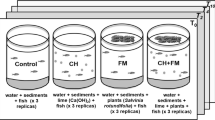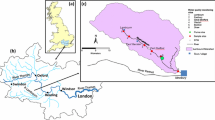Abstract
We investigated the effect of suspended clay upon the phosphorus uptake rate exhibited by lotic periphyton communities. Suspended inorganic clays and periphyton are common to aquatic environments, and both can strongly influence physical and chemical water conditions. We used replicated artificial stream channels to test the prediction that suspended clay particles would affect the uptake of soluble reactive phosphorus (SRP) by periphyton. Commercially available kaolinite and bentonite clays were characterized for their aqueous suspension behavior and affinities for SRP. Periphyton was grown in a recirculating stream system and subjected to simultaneous suspended clay and SRP additions. SRP removal from solution, both in the presence and absence of suspended clays, was used to quantify SRP uptake parameters by periphyton. Clay type and concentrations of 20, 80, and 200 mg l−1 had no significant effect upon SRP uptake rate exhibited by periphyton during three 90-min experiments. Less than 1% of SRP removal was attributable to the suspended clay load or artificial stream construction materials, based on clay isotherm data and material sorption studies, indicating that 99% of SRP removal was attributable to biotic uptake. Removal of SRP (as KH2PO4) was described by a first-order equation with rate constants ranging between 0.02 and 0.14 min−1. Our results suggest that high turbidity conditions caused by suspended mineral clays have little immediate effect upon SRP removal from the water column by periphyton.






Similar content being viewed by others
References
American Public Health Association (APHA), American Water Works Association & Water Environment Federation, 2005. Standard Methods for the Examination of Water and Wastewater. American Public Health Association, Washington, D.C.
Burkholder, J. M. & B. E. Cuker, 1991. Response of periphyton communities to clay and phosphate loading in a shallow reservoir. Journal of Phycology 27: 373–384.
Craggs, R. J., 2001. Wastewater treatment by algal turf scrubbing. Water Science and Technology 44: 427–433.
Cuker, B. E., 1987. Field experiment on the influences of suspended clay and P on the plankton of a small lake. Limnology and Oceanography 32: 840–847.
Cuker, B. E., 1993. Suspended clays alter trophic interactions in the plankton. Ecology 74: 944–953.
Cuker, B. E., P. T. Gama & J. M. Burkholder, 1990. Type of suspended clay influences lake productivity and phytoplankton community response to phosphorus loading. Limnology and Oceanography 35: 830–839.
Cuker, B. E. & C. Hudson, Jr., 1992. Type of suspended clay influences zooplankton response to phosphorus loading. Limnology and Oceanography 37: 556–576.
Davies-Colley, R. J., C. W. Hickey, J. M. Quinn & P. A. Ryan, 1992. Effects of clay discharges on streams 1. Optical properties and epilithon. Hydrobiologia 248: 215–234.
D’Angelo, D. J., J. R. Webster & E. F. Benfield, 1991. Mechanisms of stream phosphorus retention: An experimental study. The Journal of the North American Benthological Society 10: 225–237.
Dodds, W. K., 1993. What controls levels of dissolved phosphate and ammonium in surface waters? Aquatic Sciences 55: 132–142.
Dodds, W. K., 2003. The role of periphyton in phosphorus retention in shallow freshwater aquatic systems. Journal of Phycology 39: 840–849.
Doyle, R. D. & R. M. Smart, 2001. Impacts of water column turbidity on the survival and growth of Vallisneria americana winterbuds and seedlings. Journal of Lake and Reservoir Management 17: 17–28.
Froelich, P. N., 1988. Kinetic control of dissolved phosphate in natural rivers and estuaries: A primer on the phosphate buffer mechanism. Limnology and Oceanography 33: 649–668.
Gardiner, D. T. & R. W. Miller, 2004. Soils in Our Environment, 10th edn. Prentice Hall, Upper Saddle River, N.J.
Graetz, D. A. & V. D. Nair, 2000. Phosphorus sorption isotherm determination. In Pierzynski, G. M. (ed.), Methods for Phosphorus Analysis for Soils, Sediments, Residuals, and Waters. Southern Cooperative Series Bulletin No. 396: 35–38.
Graham, A. A., 1990. Siltation of stone-surface periphyton in rivers by clay-sized particles from low concentrations in suspension. Hydrobiologia 199: 107–115.
Grim, R. E., 1953. Clay Mineralogy. McGraw-Hill Book Company, Inc., New York.
Haggard, B. E., E. H. Stanley & R. Hyler, 1999. Sediment-phosphorus relationships in three Northcentral Oklahoma streams. Transactions of the American Society of Agricultural Engineers 42: 1709–1714.
Hargreaves, J. A., 1999. Control of clay turbidity in ponds. Southern Regional Aquaculture Center Publication No. 460. Mississippi State University.
Hauer, F. R. & G. A. Lamberti, 1996. Methods in Stream Ecology. Academic Press, New York.
Horner, R. R., E. B. Welch, M. R. Seeley & J. M. Jacoby, 1990. Responses of periphyton to changes in current velocity, suspended sediment and phosphorus concentration. Freshwater Biology 24: 215–232.
Klotz, R. L., 1988. Sediment control of soluble reactive phosphorus in Hoxie Gorge Creek, New York. Canadian Journal of Fisheries and Aquatic Sciences 45: 2026–2034.
Lind, O. T., 1985. Handbook of Common Methods in Limnology, 2nd edn. Kendall/Hunt Publishing Company, Dubuqe, IA: 199.
Lind, O. T., 2003. Suspended clay’s effect on lake and reservoir limnology. Archiv für Hydrobiologie Supplement, Monograph Study 139: 327–360.
Lind, O. T. & L. O. Davalos, 1990. Clay, dissolved organic matter, and bacterial interactions in two reservoirs. Archiv für Hydrobiologie 34: 119–125.
Lind, O. T., R. D. Doyle, D. S. Vodopich & B. G. Trotter, 1992. Clay turbidity: Regulation of phytoplankton production in a large, nutrient-rich tropical lake. Limnology and Oceanography 37: 549–565.
Lind, O. T., T. H. Chrzanowski & L. Davalos-Lind, 1997. Clay turbidity and the relative production of bacterioplankton and phytoplankton. Hydrobiologia 353: 1–18.
Lind, O. T. & L. Davalos-Lind, 1999. Suspended clay: Its role in reservoir productivity. In Tundisi, J. G. & M. Straskraba (eds), Theoretical Reservoir Ecology and its Applications. Brazilian Academy of Sciences and Backhuys Publishers: 85–97.
Mariñelarena, A. J. & H. D. Di Giorgi, 2001. Nitrogen and phosphorus removal by periphyton from agricultural wastes in artificial streams. Journal of Freshwater Ecology 16: 347–353.
McIntire, C. D., 1993. Historical and other perspectives of laboratory stream research. Journal of the North American Benthological Society 12: 318–327.
Murphy, J. & J. P. Riley, 1962. A modified solution method for determination of phosphate in natural waters. Analytica Chimica Acta 27: 31–36.
Newbold, J. D., J. W. Elwood, R. V. O’Neill & W. VanWinkle, 1981. Measuring nutrient spiraling in streams. Canadian Journal of Fisheries and Aquatic Sciences 38: 860–863.
Parkhill, K. L. & J. S. Gulliver, 2002. Effect of inorganic sediment on whole-stream productivity. Hydrobiologia 472: 5–17.
Peterson, B. J., W. M. Wollheim, P. J. Muholland, J. R. Webster, J. L. Meyer, J. L. Tank, E. Marti, W. B. Bowden, H. M. Valett, A. E. Hershey, W. H. McDowell, W. K. Dodds, S. K. Hamilton, S. Gregory & D. D. Morrall, 2001. Control of nitrogen export from watershed by headwater streams. Science 292: 86–90.
Pizzaro, C., E. Kebede-Westhead & W. Mulbry, 2002. Nitrogen and phosphorus removal rates using small algal turfs grown with dairy manure. Journal of Applied Phycology 14: 469–473.
Power, M. E. & A. J. Stewart, 1986. Disturbance and recovery of an algal assemblage following flooding in an Oklahoma stream. The American Midland Naturalist 117: 333–345.
Reddy, K. R., R. H. Kadlec, E. Flaig & P. M. Gale, 1999. Phosphorus retention in streams and wetlands: A review. Critical Reviews in Environmental Science and Technology 29: 83–146.
Schallenberg, M. & C. W. Burns, 2004. Effects of sediment resuspension on phytoplankton production: Teasing apart the influences of light, nutrients, and algal entrainment. Freshwater Biology 49: 143–159.
Scinto, L. J. & K. R. Reddy, 2003. Biotic and abiotic uptake of phosphorus by periphyton in a subtropical freshwater wetland. Aquatic Botany 77: 203–222.
Smith, E. P. & D. Mercante, 1989. Statistical concerns in the design and analysis of multispecies microcosm and mesocosm experiments. Toxicity Assessment 4: 129–147.
Sparks, D. L., 1989. Kinetics of Soil Chemical Processes. Academic Press, Inc., New York.
Squires, M. M. & L. F. W. Lesack, 2001. Benthic algal response to pulse versus distributed inputs of sediments and nutrients in a Mackenzie Delta lake. Journal of the American Benthological Society 20: 369–384.
Thompson, L. M. & F. R. Troeh, 1973. Soils and Soil Fertility. McGraw-Hill, New York.
Webster, I. T., P. W. Ford & G. Hancock, 2001. Phosphorus dynamics in Australian lowland rivers. Marine and Freshwater Research 52: 127–137.
Wilber, C. G., 1983. Turbidity in the Aquatic Environment: An Environmental Factor in Fresh and Oceanic Waters. Charles C. Thomas, Springfield, Illinois.
Wilkie, A. C. & W. W. Mulbry, 2002. Recovery of dairy manure nutrients by benthic freshwater algae. Bioresource Technology 84: 81–91.
Wood, P. J. & P. D. Armitage, 1997. Biological effects of fine sediment in the lotic environment. Environmental Management 21: 203–217.
Acknowledgments
This work has been graciously supported through grants, time, expertise, and/or facilities of the Texas AgriLife Research/Blackland Research and Extension Center, Texas Water Resource Institute, U.S. Department of Agriculture, and Baylor University. The authors gratefully acknowledge the valuable contributions of time and comments given by Allen Torbert, Ken Potter, Arthur Stewart, Armen Kemanian, and several anonymous reviewers.
Author information
Authors and Affiliations
Corresponding author
Additional information
Handling editor: D. Ryder
Rights and permissions
About this article
Cite this article
Wolfe, J.E., Lind, O.T. Influence of suspended clay on phosphorus uptake by periphyton. Hydrobiologia 610, 211–222 (2008). https://doi.org/10.1007/s10750-008-9436-7
Received:
Revised:
Accepted:
Published:
Issue Date:
DOI: https://doi.org/10.1007/s10750-008-9436-7




